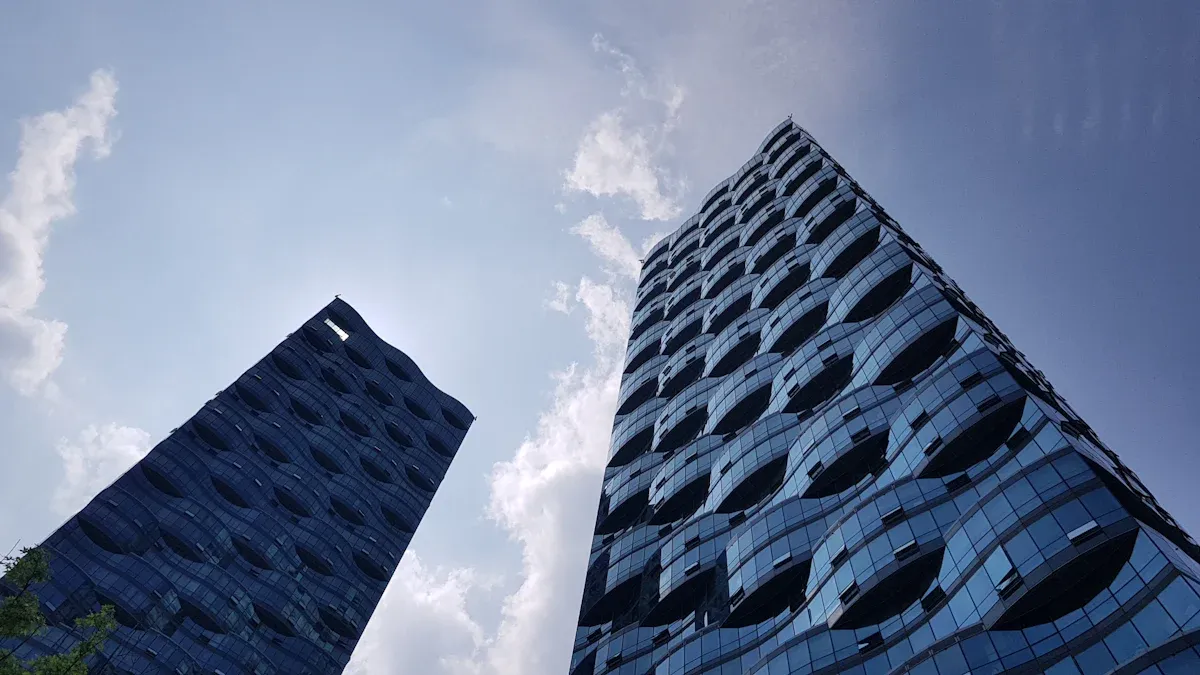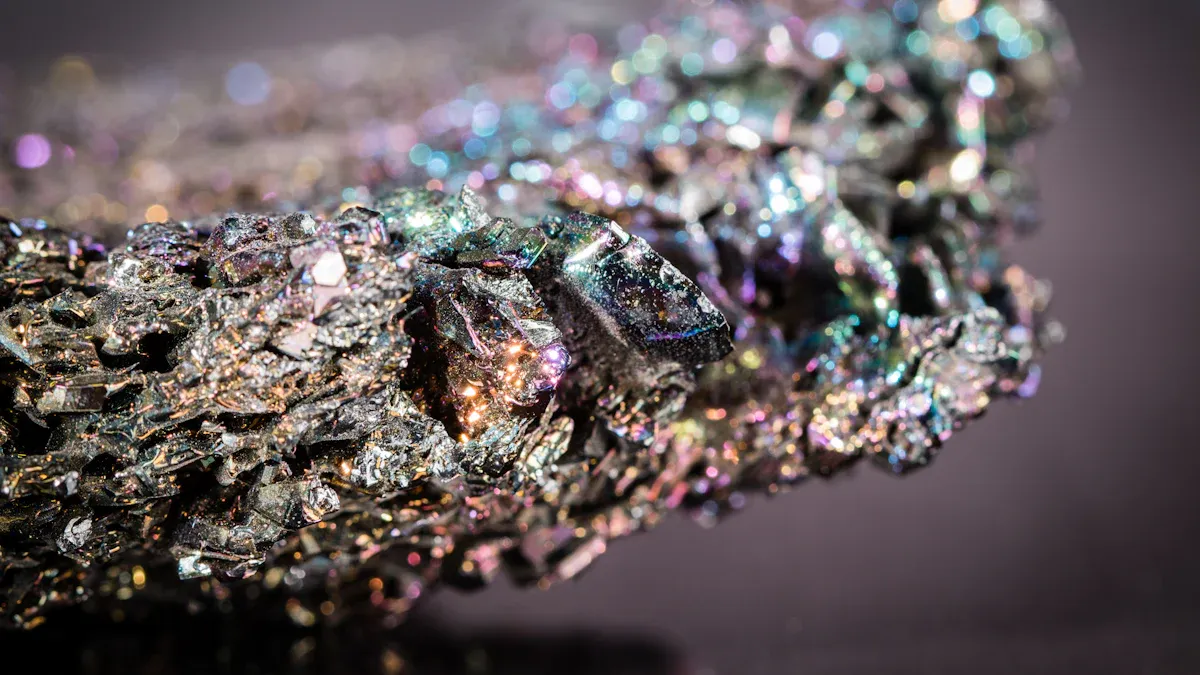
Korean researchers have achieved remarkable progress in developing advanced CVD SiC paddles. These paddles, essential for semiconductor manufacturing equipment, demonstrate exceptional durability under extreme conditions. By integrating innovative life extension technologies, such as enhanced sic coating and advanced CVD coating techniques, the paddles resist thermal degradation more effectively. These advancements significantly improve performance and reliability in high-temperature vacuum environments, ensuring prolonged operational life. The breakthrough underscores the critical role of material innovation in addressing industry demands for efficiency and cost-effectiveness.
Key Takeaways
- Korean scientists created stronger CVD SiC paddles for high-heat vacuums, important in making semiconductors.
- New life-extending methods, like better coatings and designs, make these paddles last longer and lower repair costs.
- CVD SiC paddles work well even in tough conditions, helping semiconductors get made faster and better.
- Using pure silicon carbide and smart building methods keeps quality steady, helping industries like cars and green energy.
- More studies and improvements are coming to meet needs for saving energy and advanced technology.
Background and Challenges
Role of CVD SiC Paddles in High-Temperature Vacuum Environments
CVD SiC paddles play a critical role in high-temperature vacuum environments, particularly in semiconductor manufacturing. These paddles, often made from SiC-coated graphite substrates, are essential for metal-organic chemical vapor deposition (MOCVD) processes. Their primary function is to support thin film preparation, a key step in producing high-quality semiconductor devices.
The thermal stability of CVD SiC paddles ensures they maintain their structural integrity under extreme temperatures. This stability is vital for preserving the purity and consistency of semiconductor films. Additionally, their chemical inertness minimizes reactions with corrosive gases, which are commonly present in these environments. The oxidation resistance of SiC coatings further enhances their performance by preventing material degradation during prolonged exposure to high temperatures. These attributes collectively contribute to the efficiency and reliability of semiconductor production systems.
Challenges in Development: Material Degradation and Performance Limitations
Developing CVD SiC paddles that can withstand the harsh conditions of high-temperature vacuum environments presents significant challenges. Material degradation is one of the primary obstacles. Prolonged exposure to extreme heat and reactive gases can weaken the structural integrity of the paddles, leading to reduced performance and shorter lifespans.
Performance limitations also arise from the need to balance thermal stability with other critical properties, such as chemical resistance and mechanical strength. Achieving this balance requires advanced materials and innovative manufacturing techniques. For instance, the SiC coating must be precisely engineered to ensure uniformity and durability. Any inconsistencies in the coating can compromise the paddle’s effectiveness, impacting the overall efficiency of the semiconductor manufacturing process.
Despite these challenges, ongoing research and development efforts continue to push the boundaries of what is possible, resulting in more robust and reliable CVD SiC paddles.
Development Process

Research and Development Efforts in Korea
Korean researchers have invested significant resources into advancing the development of CVD SiC paddles. Their efforts focus on addressing the challenges posed by high-temperature vacuum environments. Research teams prioritize material innovation to enhance thermal stability and chemical resistance. Laboratories across Korea collaborate with industry leaders to test new designs and manufacturing techniques. These partnerships accelerate the development process and ensure alignment with industry needs.
Government support plays a crucial role in fostering innovation. Funding programs and research grants enable scientists to explore cutting-edge technologies. Universities and research institutes contribute by conducting experiments and analyzing performance data. These institutions provide valuable insights into material behavior under extreme conditions. Their findings guide the optimization of CVD SiC paddles for durability and efficiency.
Innovative Techniques and Materials for Enhanced Durability
The development of CVD SiC paddles relies on innovative techniques and advanced materials. Engineers employ precision chemical vapor deposition methods to create uniform SiC coatings. These coatings improve thermal resistance and protect the paddles from oxidation. Researchers refine deposition parameters to achieve consistent thickness and adhesion. This precision ensures the paddles maintain their structural integrity during prolonged use.
Material selection is another critical factor. High-purity silicon carbide enhances the mechanical strength of the paddles. Its chemical inertness minimizes reactions with corrosive gases, extending the lifespan of the equipment. Engineers also explore composite materials to balance strength and weight. These composites reduce stress on the paddles while maintaining their performance in demanding environments.
Testing and validation processes confirm the effectiveness of these innovations. Researchers simulate high-temperature vacuum conditions to evaluate durability. Data from these tests demonstrate significant improvements in paddle performance. These advancements position Korean CVD SiC paddles as reliable solutions for semiconductor manufacturing.
Life Extension Technology
Advanced Coatings for Thermal Resistance
Advanced coatings play a pivotal role in enhancing the thermal resistance of CVD SiC paddles. These coatings are engineered to withstand extreme temperatures while maintaining structural integrity. Researchers have developed innovative thermal spray coatings that significantly improve performance in high-temperature environments. Low thermal conductivity coatings, for instance, reduce heat transfer, ensuring the paddles remain stable during prolonged exposure to heat.
Recent studies highlight the effectiveness of thermal barrier coatings (TBCs) in improving durability. These coatings exhibit superior thermal conductivity compared to traditional alternatives. Additionally, ongoing research focuses on enhancing fracture toughness and erosion resistance, further extending the lifespan of the paddles. By incorporating these advancements, manufacturers can ensure reliable operation in demanding vacuum environments.
Structural Improvements for Durability
Structural enhancements are essential for improving the durability of CVD SiC paddles. Engineers have introduced design modifications that optimize the mechanical strength of these components. High-purity silicon carbide materials are utilized to reinforce the paddles, providing exceptional resistance to mechanical stress. This approach minimizes the risk of structural failure during operation.
Composite materials are also gaining traction in paddle development. These materials combine lightweight properties with high strength, reducing stress on the paddles without compromising performance. Precision manufacturing techniques ensure uniformity in structure, eliminating weak points that could lead to premature wear. These structural improvements contribute to the long-term reliability of the paddles in high-temperature vacuum environments.
Effectiveness of Life Extension Technologies: Data and Examples
The effectiveness of life extension technologies is evident through data and practical applications. Thermal resistance improvements achieved through advanced coatings have been validated in various studies. For example:
- Thermal spray coatings have shown significant benefits in gas turbines and energy generation systems.
- Low thermal conductivity coatings have demonstrated enhanced performance in high-temperature settings.
- Thermal barrier coatings exhibit promising results in both durability and thermal conductivity.
- Research continues to improve fracture toughness and erosion resistance, ensuring long-term reliability.
In real-world applications, these advancements have translated into measurable benefits. Semiconductor manufacturers report increased operational lifespans for CVD SiC paddles, reducing the frequency of replacements. This improvement not only lowers maintenance costs but also enhances production efficiency. The integration of advanced coatings and structural improvements ensures that these paddles meet the rigorous demands of modern semiconductor processes.
Benefits and Applications

Increased Lifespan and Cost Efficiency
The advanced design and material innovations in CVD SiC paddles have significantly extended their operational lifespan. This improvement reduces the frequency of replacements, leading to lower maintenance costs. For instance, the willingness to pay (WTP) for a one-year increase in lifespan is estimated at $37.6 trillion, highlighting the immense economic value of durability enhancements. Furthermore, the integration of high-purity silicon carbide and advanced coatings ensures that these paddles deliver consistent performance over time, maximizing resource efficiency.
Cost efficiency is further enhanced by the ability of these paddles to withstand extreme conditions without degradation. By minimizing downtime and repair needs, manufacturers can allocate resources more effectively. The use of innovative materials also reduces the need for virgin material extraction, contributing to sustainability and cost savings.
Reliability in High-Temperature Vacuum Environments
CVD SiC paddles demonstrate exceptional reliability in high-temperature vacuum environments. Their thermal conductivity, measured at approximately 300 W/mK or higher, ensures efficient heat management. Additionally, impurity levels remain below 5 ppm, maintaining the purity required for semiconductor manufacturing. These attributes enable the paddles to perform consistently under demanding conditions, ensuring uninterrupted operations.
The structural integrity of these paddles also plays a crucial role in their reliability. Composite materials and precision manufacturing techniques eliminate weak points, reducing the risk of failure. This reliability translates into improved production efficiency and reduced operational risks for industries relying on high-temperature processes.
Industries and Applications Benefiting from CVD SiC Paddles
The benefits of CVD SiC paddles extend across multiple industries. In semiconductor manufacturing, these paddles support critical processes like thin-film deposition, ensuring high-quality output. The renewable energy sector also benefits, as SiC-based systems improve energy efficiency by 10-20%. Additionally, the automotive industry leverages these paddles for electric vehicle production, enhancing drivetrain performance and reducing emissions.
Innovations such as additive manufacturing and smart materials further expand the applications of CVD SiC paddles. These advancements optimize paddle designs, improving cooling efficiency and thermal management. By enabling recycling of silicon carbide, these paddles also contribute to sustainability, reducing the need for virgin material extraction by up to 30%.
The successful development of Korean CVD SiC paddles marks a significant milestone in material innovation. These paddles, enhanced by life extension technologies, deliver unmatched durability and performance in high-temperature vacuum environments. Future advancements promise even greater potential, as shown below:
| Innovation | Impact |
|---|---|
| Crystal Growth Techniques | Improved wafer quality for high-voltage applications. |
| Additive Manufacturing | Optimized paddle designs for better cooling efficiency. |
| Smart Materials | Enhanced thermal management and extended lifespan. |
These innovations align with growing market demands, particularly in energy-efficient and high-tech industries.
By: Semicera
E-mail: sales01@semi-cera.com
E-mail: sales05@semi-cera.com
Tel: 86-0574-8650 3783
Phone: 86-13373889683
FAQ
1. What are CVD SiC paddles used for?
CVD SiC paddles are primarily used in semiconductor manufacturing. They support thin-film deposition processes in high-temperature vacuum environments. Their thermal stability and chemical resistance ensure consistent performance, making them essential for producing high-quality semiconductor devices.
2. How do advanced coatings improve paddle performance?
Advanced coatings enhance thermal resistance and protect against oxidation. These coatings reduce heat transfer and prevent material degradation. By maintaining structural integrity under extreme conditions, they extend the operational lifespan of the paddles.
3. What industries benefit from CVD SiC paddles?
Industries such as semiconductor manufacturing, renewable energy, and automotive production benefit from CVD SiC paddles. These paddles improve efficiency in thin-film deposition, energy systems, and electric vehicle components, ensuring reliable performance in demanding applications.
4. How do structural improvements enhance durability?
Structural improvements, such as using high-purity silicon carbide and composite materials, increase mechanical strength. These enhancements minimize stress and eliminate weak points, reducing the risk of failure during operation.
5. Why are Korean CVD SiC paddles considered innovative?
Korean CVD SiC paddles incorporate cutting-edge materials and manufacturing techniques. They feature advanced coatings, optimized designs, and superior thermal resistance. These innovations address industry challenges, ensuring durability and cost efficiency in high-temperature vacuum environments.